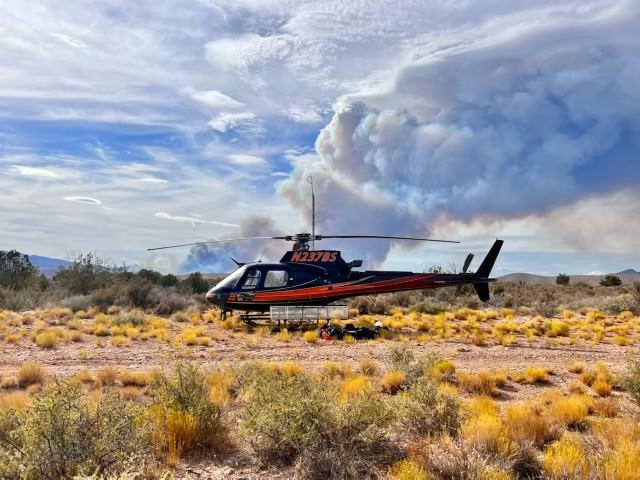You are viewing ARCHIVED content published online before January 20, 2025. Please note that this content is NOT UPDATED, and links may not work. Additionally, any previously issued diversity, equity, inclusion or gender-related guidance on this webpage should be considered rescinded. For current information, visit https://www.blm.gov/blog.
Arizona Strip District's Moki Helitack Season 2022 in Review
As the peak wildfire season has started to wane in Arizona and in portions of the western United States, we look back at Moki Helitack’s 2022 season. Moki is based on the Arizona Strip District, in St. George, UT and dispatched out of the Color Country Dispatch Center in Cedar City, UT. Moki Helitack is one of BLM Arizona’s two helitack crews, the other is Weaver Mountain Helitack based on the Phoenix District, northwest of Wickenburg. [Stay tuned for their season in review.]


Kitt Peak Observatory in southern Arizona.
In 2022 Moki Helitack ended up with 189 flight hours for the season - 55.7 of those hours were flown in the Color Country Dispatch Area, and 133.3 hours were flown off district. This included operations in six states this year - Arizona, Utah, Nevada, Idaho, Montana, and Oregon. Cumulatively, over all the missions performed the crew and its helicopter dropped 54,755 gallons of water and flew 439 passengers. They responded to and worked 35 initial attack fires and supported two Type 1 (large fires with high complexity, and significant values at risk) incidents, including the Contreras Fire in southern Arizona, and the Elmo 2 Fire in Montana, and later supporting a prescribed fire in Idaho. This crew is also qualified to perform Single-Skid, Toe-In and Hover Exit/Entry Procedures (STEP). They had 3 operational STEP maneuvers this season - 2 toe-in exits and 1 hover exit. Moki is one of less than 10 helitack crews in the nation with this specialized training that improves response time to fires and increases the efficiency and efficacy of inserting and extracting wildland firefighters on incidents.
Their adventures began in mid-May and through much of June they spent 30 days working within Arizona on a combination of initial attack responses and in support of large fires. Later in June through August, the crew and their helicopter moved back into northern Arizona and southern Utah, responding to initial attack fires and the occasional extended attack fire. As their summer continued their journey in early August moved north and west to assist with fire activity in 3 different states, for a total of 52 days. First was Montana, assigned to the Elmo 2 Fire. Once their mission was complete, they moved on to Oregon where they supported initial attack response. They finished out their contract in Idaho, helping BLM Idaho’s Boise District, with ignition operations on a prescribed fire using a Plastic Sphere Dispenser (PSD). This device is mounted at the helicopter door and dispenses small plastic spheres; these plastic spheres contain a powder and are injected with a reactant liquid while in the PSD to create a delayed chemical reaction, which is then ejected from the PSD, resulting in a flame, and ignition of the dry vegetation on the ground.
Their helitack crew supervisor, Cory Johnson, described their season as being, “much like Lord of the Rings, as a trilogy,” for this fellowship of eight, with the three major transitions and their diverse mission assignments. The helicopter assigned to the crew was originally contracted for 90 days, and extended for another 35 days, indicative of the continued need of this helicopter and the crew beyond what was originally planned.
Some more interesting facts from Moki’s season - in total from May-Sept they drove 30,433 miles on the 3 vehicles which carry the crewmembers to and from missions and assignments.
This season they took on seven detailers, providing training and experience for a helicopter manager trainee, and at least four helicopter crew members and trainees. The individuals in these details came from the Arizona Strip District, North Cascades National Park, as well as the Dixie and Humboldt-Toiyabe National Forests. The crew also had 7 of their own crewmembers take developmental fire assignments. Individuals in the Moki program were able to complete task books – within their crew they were able to certify one as a Division Supervisor, two as Plastic Sphere Dispenser Operators, and get two helicopter crew member trainees to fully qualified helicopter crewmembers.
Overall, it appears that the Moki Helitack had a safe and successful season.
Related Stories
- Progress on Public Lands: BLM 2025 Trump Administration Accomplishments | January 20 - December 31, 2025
- Remembering the cattle drive that defined ranching in southeastern Arizona
- Smokey Bear joins Mr. & Mrs. Claus to continue LTVA annual toy giveaway
- BLM Fire Team brings Smokey Bear to Kingman’s Street of Lights
- Rural wildland firefighting partners grateful for BLM gift
